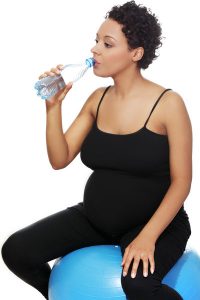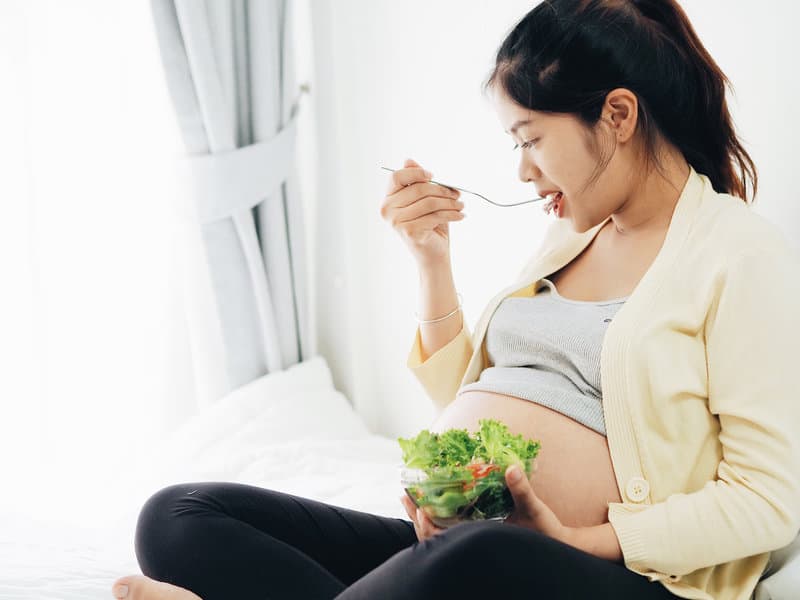Factsheet – Managing labour: Mood, Mobilise and Munch (part 2 of 3)
Trixie McAree
Professor of Midwifery and Maternal Health, Birmingham City University
@mcareetrixie (Twitter)
Summary
Birth (reproduction) is a physiological process that shows we are alive, other signs of life include eating (nutrition), excretion and breathing (respiration). However, it would seem that we struggle more with birth than any of the other elements of life.
In 2017/18, 52.2% of women commenced labour spontaneously, with 57% of women giving birth spontaneously1, as opposed to requiring either instrumental or caesarean interventions for birth. This suggests almost half of births require additional external intervention, giving rise to the question: What can we do to support our bodies doing what they was designed to do and give birth in the healthiest way possible?
Although there are no guarantees for an easy labour this factsheet series explores three keys to physiological labour where potentially harmful or unnecessary intervention is kept to a minimum. They are managing your mood, mobilising prior to and during labour and munching throughout labour. This factsheet looks at munching – eating and drinking in labour to support normal physiological processes.
Link to Mobilise Factsheet – this article
Link to free flow article: How to have a positive birth
What we know
 The World Health Organisation recently reviewed all the guidance written for pregnant women, a high proportion of them mention the value of exercise during pregnancy. This is because exercise improves general fitness and stamina needed for labour, improving your chances of vaginal birth2-4 increased birth weight and fetal well being.5
The World Health Organisation recently reviewed all the guidance written for pregnant women, a high proportion of them mention the value of exercise during pregnancy. This is because exercise improves general fitness and stamina needed for labour, improving your chances of vaginal birth2-4 increased birth weight and fetal well being.5
Antenatal exercise is powerful because studies conclude that it has a significant impact on your mood by enhancing optimism and reducing fear6 and is thought to both prevent and treat antenatal depression although at this point evidence base is not certain.7 This information can be used to help prepare for labour.
Once in labour, perceived wisdom suggests mobilising is helpful, and this is discussed in a Cochrane systematic review.8 The reasons for this are two-fold –one is that position is thought to work with gravity and mechanics of birth making the birthing process easier. The second is that by being upright a woman may feel more in control and through gaining the psychological advantage cope better with labour and thus her body works more efficiently due to a reduction in adrenaline. Lying down is an act of submission – rather like going to the dentist even when logically you know that the person caring for you intends good. This relates to third key part which is linked is managing mood and is discussed here.
It seems clear from the research that has been undertaken that having freedom to move, and work with labour in an intuitive fashion is helpful to reducing discomfort and avoiding unnecessary interventions9.
Researchers looking at maternal position at second stage for women with epidural concluded that women “lying down” had more spontaneous vaginal births, than those sitting up. However, when reading this document you could easily think they mean a supine (lying position), but the authors describe lying down as either left or right lateral or lying on your side probably with one knee raised forwards towards abdomen to stabilise – which has is considered a helpful position to be in, supporting fetal positioning. The alternative position they refer to includes a standing position, but more likely would be a sitting up position. Standing or kneeling with an epidural is not common in hosptital maternity units. The difficulty with a “sitting positon” is that women may very possibly find them in a semi-recumbent position (upright positioning of the head and torso at an angle of 45°) as it is very hard to get the pelvis on a vertical plane whilst being in the bed, women can easily slide down the bed.
A good way to move around and feel in control with minimal pressure on the body and with good effectiveness to reduce discomfort is use of water. For information about labour and birth in the water- click here.
What we don’t know
Exercise seems to enhance general physical and mental health being but research to date is not entirely conclusive often due the fact they studies that have been undertaken are small.11 In addition it is thought that exercise may reduce the incidence of gestational diabetes and pre-eclampsia but so far there has not been a study of sufficient size to demonstrate that these are true.
In giving birth we are dealing with a complex multifactorial process which makes it difficult to test and prove what will work the best for women. Pregnant women participating in clinical trials can be problematic as this influences their autonomy and choice, therefore alternative methods of data collection need to be carefully considered. However using common understanding of mechanics, physiology and psychology suggests that women should be move as they feel most comfortable and follow their natural instincts, remaining upright or in an all fours position12, allowing maximum opening of the pelvis where possible.
Mothers and families: how to use the evidence
- Prepare for labour by exercising regularly 30 minutes several times a week throughout the antenatal period. Discuss with midwife or GP if any concerns around this
- Plan to move in labour, test and practice positions you like
- Feel free to follow your instincts about what feels comfortable for you and tell your midwife so she can support you
- Move the bed to the side of the room so that you do not feel obliged to lie on it, use it for buoyancy – such as pumping it up and leaning against it
- Ask your midwife about water birth – make full use of this facility as it will help you be mobile in labour
Midwives and birth workers: how to use the evidence
- Encourage women to exercise during pregnancy,
- Practice positions they might like to use in labour.
- Show them and encourage them to test out birth ball, and other equipment available
- Provide a tour of the birth areas in your organisation. Showing women options of additional equipment, how to move the bed away to the side of the room and how to use the bed as a piece of equipment to enable comfort rather than being used to lie on it “patient style”
Links to other resources
 Videos
Videos
Facebook: How to use a birth room to maximise upright birth
Antenatal breathing and relaxation for labour
Comfort Measures Support in Labour
 Guidelines
Guidelines
Intrapartum care for healthy women and babies – Clinical guideline [CG190] Care during labour
Cochrane -Maternal positions and mobility during first stage labour
WHO recommendation on adoption of mobility and upright position during labour in women at low risk
Royal College of Midwives – Midwifery care in labour guidance for all women in all settings
 Books
Books
Milli Hill: Give Birth Like a Feminist
Rhea Dempsey: Birth with Confidence
 Websites
Websites
Evidence-based birth – positions in labour and their effects on pain relief
References
-
NHS Digital. Maternity Services Monthly statistics Dec 2019, experimental statistics. https://digital.nhs.uk/data-and-information/publications/statistical/maternity-services/december-2019, 2019.
-
Silveira LC, Segre CA. Physical exercise during pregnancy and its influence in the type of birth. Einstein (Sao Paulo) 2012; 10(4): 409-14.
-
Domenjoz I, Kayser B, Boulvain M. Effect of physical activity during pregnancy on mode of delivery. Am J Obstet Gynecol 2014; 211(4): 401.e1-11.
-
Price BB, Amini SB, Kappeler K. Exercise in pregnancy: effect on fitness and obstetric outcomes-a randomized trial. Med Sci Sports Exerc 2012; 44(12): 2263-9.
-
Bisson M, Alméras N, Plaisance J, et al. Maternal fitness at the onset of the second trimester of pregnancy: correlates and relationship with infant birth weight. Pediatr Obes 2013; 8(6): 464-74.
-
Guszkowska M. The effect of exercise and childbirth classes on fear of childbirth and locus of labor pain control. Anxiety Stress Coping 2014; 27(2): 176-89
-
Daley AJ, Foster L, Long G, et al. The effectiveness of exercise for the prevention and treatment of antenatal depression: systematic review with meta-analysis. BJOG 2015; 122(1): 57-62.
-
Lawrence A, Lewis L, Hofmeyr GJ, Dowswell T, Styles C. Maternal positions and mobility during first stage labour. Cochrane Database Syst Rev 2009; (2): CD003934.
-
Gizzo S, Di Gangi S, Noventa M, Bacile V, Zambon A, Nardelli GB. Women’s choice of positions during labour: return to the past or a modern way to give birth? A cohort study in Italy. Biomed Res Int 2014; 2014: 638093.
-
Group EaPTC. Upright versus lying down position in second stage of labour in nulliparous women with low dose epidural: BUMPES randomised controlled trial. BMJ 2017; 359: j4471.
-
Perales M, Santos-Lozano A, Ruiz JR, Lucia A, Barakat R. Benefits of aerobic or resistance training during pregnancy on maternal health and perinatal outcomes: A systematic review. Early Hum Dev 2016; 94: 43-8.
-
Stremler R, Hodnett E, Petryshen P, Stevens B, Weston J, Willan AR. Randomized controlled trial of hands-and-knees positioning for occipitoposterior position in labor. Birth 2005; 32(4): 243-51.










